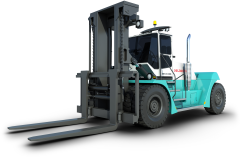Forklifts Information
 Forklifts (fork lifts) are used to engage, lift and transfer palletized loads in material handling, warehousing, manufacturing, and construction applications. There are three basic types: manual drive, motorized drive, and fork truck.
Forklifts (fork lifts) are used to engage, lift and transfer palletized loads in material handling, warehousing, manufacturing, and construction applications. There are three basic types: manual drive, motorized drive, and fork truck.
- Fork trucks - Also motorized, but include features such as cabs and backup alarms.
- Manual-drive forklifts - The load movement or travel is manually powered or walk-behind.
- Motorized-drive forklifts - These have a motorized drive and, in many cases, a protected cab or seat for the driver.
Some forklifts are counterbalanced to prevent the vehicle from overturning. Others include hand rails, safety rails, or a rotating element such as a turntable. Truck-mounted forklifts are mounted or mountable on the back or bed of a utility truck. These vehicles include truck-included packages as well as lifts that are sold independently for subsequent mounting.
Forklift Classes
There are eight different classes of forklifts.
| Class I | Forklifts are electric-motor rider trucks, either stand-up operator or seated three-wheel units. Rider units are counterbalanced and may have cushion or pneumatic wheels. |
| Class II | Forklifts are electric-motor trucks for narrow aisle or inventory stock/order picking applications. They may have extra reach or swing-mast functions. |
| Class III | Forklifts are electric-motor trucks, either walk-behind or standing-rider operated. Automated pallet lift-trucks and high lift models are often counterbalanced. |
| Class IV | Forklifts are rider fork trucks, with cabs and seated controls, internal combustion engines, and solid or "cushion" tires. |
| Class V | Forklifts are rider fork trucks, with cabs and seated controls, internal combustion engines, and pneumatic tires. Like Class IV forklifts, they are typically counterbalanced. |
| Class VI | Forklifts are sit-down rider, tow tractor lifts. They are supplied with electric or internal combustion engines. |
| Class VII | Forklifts are designed for use on rough terrain. Typical applications include agriculture, logging and construction. |
| Class VIII | Forklifts include all personnel and burden carriers. |
Specifications
Lift capacity and stroke are important specifications to consider when selecting forklifts. Lift capacity is the maximum, supportable force or load. Stroke is the difference between the fully-lowered and fully-raised lift positions.
Additional specifications for forklifts include fuel type and tire type. Fuel choices include:
- Electricity
- Liquid propane (LP)
- Natural gas
- Compressed natural gas (CNG)
- Propane
- Gasoline
- Diesel fuel
 There are two basic tire types for forklifts and fork trucks: pneumatic and solid. Pneumatic or air-inflated tires provide great load-cushioning and drive traction. Solid or cushion tires do not puncture and require less maintenance than pneumatic tires; however, solid or cushion tires offer less shock absorption.
There are two basic tire types for forklifts and fork trucks: pneumatic and solid. Pneumatic or air-inflated tires provide great load-cushioning and drive traction. Solid or cushion tires do not puncture and require less maintenance than pneumatic tires; however, solid or cushion tires offer less shock absorption.
Standards
A-A-58067 - Truck, lift, fork, diesel-engine-driven, pneumatic-tired, 15,000 pounds capacity at 24 inch load center
A-A-58068 - Truck, lift, fork, electric, sit down, solid tires, 6000 pound capacity at 24 inch load center, 180 inch minimum lift height
A-A-58069 - Truck, lift, fork, electric, order selector, high lift rider, 3000 pound capacity, 193 inch minimum lift
Image credits:
- Alabama
- Arizona
- California
- Colorado
- Connecticut
- Florida
- Georgia
- Iowa
- Illinois
- Indiana
- Kansas
- Kentucky
- Louisiana
- Massachusetts
- Maryland
- Michigan
- Minnesota
- Missouri
- Mississippi
- North Carolina
- New Jersey
- New Mexico
- Nevada
- New York
- Ohio
- Oklahoma
- Oregon
- Pennsylvania
- South Carolina
- South Dakota
- Tennessee
- Texas
- Utah
- Virginia
- Washington
- Wisconsin
- Wyoming
- Class I - Electric Motor Rider Truck
- Class II - Electric Motor Narrow Aisle Truck
- Class III - Electric Motor Hand Truck
- Class IV - Internal Combustion Truck / Cushion Tires
- Class V - Internal Combustion Truck / Pneumatic Tires
- Class VI - Electric and Internal Combustion Tractor
- Class VII - Telehandler
- Class VIII - Hand Pallet Truck
- Diesel
- Electric
- Gasoline
- LP
- Narrow Aisle
- Natural Gas / CNG
- Pneumatic
- Solid / Cushion
- Stacker / Walkie
- forklift load capacity
- manual forklift
- forklift battery connector
- forklift specification
- forklift attachment
- forklift drawings
- heil truck hoist
- 180 degree rotator forklift
- forklift jack
- hyster forklift hydraulic
- stacker truck
- 50000 lbs fork lift
- forklift broom
- forklift truck importer
- forklifts entwistle
- inverter forklift
- rough terrain forklift trucks
- swing reach forklift truck
- 500kg electric forklift
- forklift shock switch
- max height lifting forklift
- 1980 lull fork lifts
- 30000 lbs fork lifts
- 40000 lb capacity fork lifts
- 8000 lb fork lifts
- articulated forklift trucks
- AutoCAD drawing fork lifts
- climax forklift trucks
- cone wheel fork lifts
- diecast model forklift trucks
